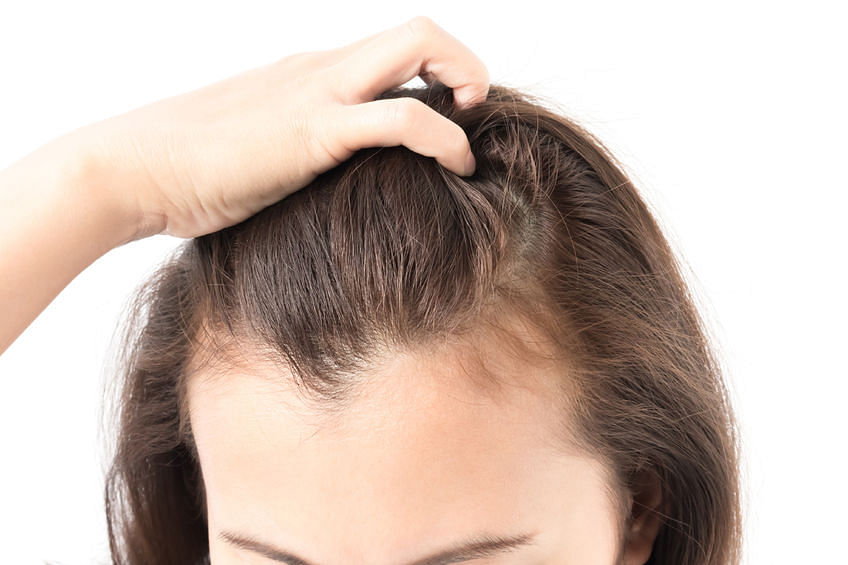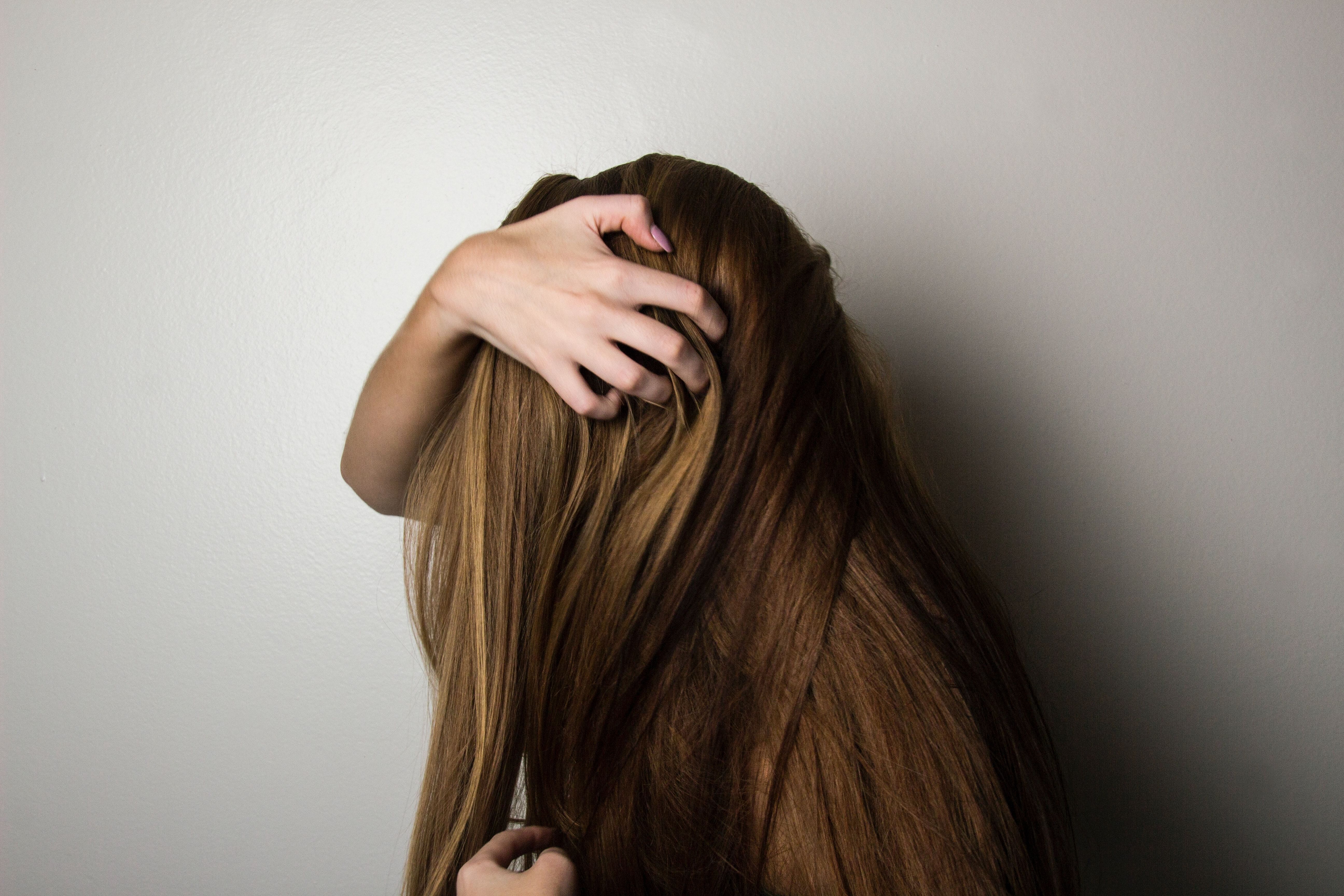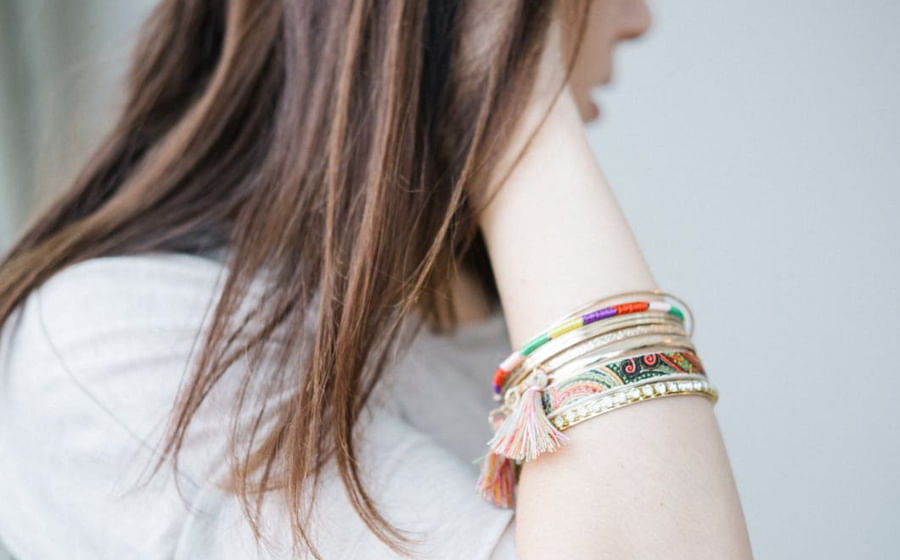Did you know that we have about 120,000 to 150,000 hair follicles on our scalp when we are born? Each of these hair follicles are able to produce hair for an average of 25 cycles through our entire life when the hair follicles are kept healthy and not damaged. For example, some hair fall when you’re shampooing your hair or combing your locks is to be expected. In fact, losing about 50-100 strands of hair per day is totally normal and no cause for alarm.
However, a change in hormones, improper diet, stress, genetics, vitamin deficiencies, illness, and even bleaching or perming can cause hair thinning. Diseases more common to women, such as thyroid disease, autoimmune illness, iron deficiency and lupus, are culprits that contribute to hair loss. Oral contraceptives can also contribute to hair loss as the hormones in birth control that suppress ovulation can cause thinning hair and hair loss. But when is it actually time to worry? Here are the top signs of thinning hair and what you can do about it:
#1: Hair Clumps

Photo: Pexels
If your hair falls in strands, then chances are, you have nothing to worry about. However, if you notice that your hair is falling off in clumps when you run your fingers through your hair or brush your hair, it’s likely a sign of thinning hair. Keep a lookout for any bald patches on your scalp as these two are usually related. Other signs include an increased amount of hair in the shower after shampooing or even on your pillow case.
#2: More Visible Scalp
As hair thinning occurs gradually and not overnight, a decrease in hair volume is generally tricky to spot because we regularly touch our hair each time we shampoo. If you start to notice that your scalp is becoming more visible at the hairline around your face or at your hair parting, that could also indicate that your hair might be thinning. A number of reasons could lead to this, including frequent combing which can result in accelerated hair fall, as well as excessive pressure on your scalp along your hair parting from long hours of tying your hair up into a tight ponytail or hair bun.
#3: Thinner Ponytail
For those with longer hair, pay attention to the thickness of your ponytail or hair bun—if your ponytail is getting thinner or the size of your hair bun is getting smaller, you might be facing thinning hair. How tight your ponytail is fastened and how heavy your hair weighs can also contribute to hair thinning. So if you notice that your ponytail feels thinner or that it takes more twists of your hair elastic to fasten your hair, you might have thinning hair.
#4 Your Forehead Looks Wider
Another tell-tale sign is if your forehead starts to look wider as your hairline recedes further backwards. Look back on old photos taken at a few months’ interval. As most thinning hair occurs first around the crown of your head, if you’re facing thinning hair, you might notice a receding hairline based on how much larger your forehead appears to be.
#5 Excess Shedding
On average, it is totally normal and healthy if you shed anywhere between 50 to 100 strands of hair daily, like mentioned earlier. Of course, we won’t be counting each individual strands that fall off our scalp over the course of the day, but if your hair falls in strands, then chances are, you have nothing to worry about.
However, if you notice that your hair falls off in clumps when you run your fingers through your hair or brush your hair, or even on your pillow case from tossing and turning, it’s likely that you are showing signs of thinning hair. You can also keep a lookout for any bald patches on your scalp as these two are usually related.
What to do to prevent thinning hair

Photo: Pexels
There are many lifestyle changes you can make and bad habits you can kick to avoid hair loss that’s not caused by hormonal changes or hereditary factors.
Avoid tight hairstyles such as braids, buns or ponytails. These styles tug at the hair follicles over long periods of time and gradually weaken and damage them. You can also use a wide-toothed detangling comb as it is less likely to yank at your hair and cause breakage and damage to hair follicles. Keep heat styling and harsh chemical processes to a minimum. These can affect the health of your scalp and hair follicles and cause premature hair thinning. Lastly, protect your scalp like you would your skin. Use an umbrella when you’re outdoors and if possible, apply a UV-protecting mist on your hair and scalp to shield it from harmful UV rays and free radicals.
What you can use
There are many topical products as well as clinical treatments that are designed to restore scalp health for fuller, healthier hair. Here are some to try:
https://www.herworld.com/style/beauty/hair/sneaky-signs-losing-thinning-hair-fall-what-to-do/
Sneaky signs you are losing hair and what to do about it_gallery
Plantur 39 Phyto-Caffeine Tonic, $19.90
image
Specially formulated to cater to women above the age of 40, caffeine is the key ingredient of this scalp tonic as it instantly boosts micro-circulation in the scalp so that hair follicles receive more nutrients and oxygen. At the same time, niacin and zinc also help thicken hair growth so your hair becomes fuller and more voluminous over time.
ICM Pharma Growell Scalp Lotion, $69.75
image
At the heart of this formula is Minoxidil, a powerful ingredient that’s clinically proven to offer visible results for those who are facing hair loss. All you have to do is apply twice daily onto scalp and massage to boost absorption and stimulate micro-circulation. When absorbed into the scalp, it works by rejuvenating hair follicles and helping them function optimally again. Its mess-free spray pump helps reduce wastage and enables you to apply precisely on areas needed effortlessly.
PHS Hairscience FEM Thickening Shampoo, $45
image
PHS Hairscience products are developed to deliver essential nutrients to hair and scalp for accelerated repair and regeneration of hair cells for denser and healthier hair growth. Made of Korean botanical essences, this is a gentle, hypoallergenic cleanser that restores hair thickness and resilience with its key ingredient, pea protein.
SW1 Clinic Hair Recovery Strengthening & Rejuvenating Serum, $192.60
image
This is a topical serum for your scalp. It contains active ingredients like 5 per cent Minoxidil, Gingko Biloba and Vitamin B6 to strengthen damaged hair and stimulate hair follicles for healthier, thicker hair growth. Designed to be applied directly onto your scalp once or twice a day as directed by your doctor, the lightweight serum doesn’t leave behind any sticky or greasy residue so you can proceed to hair styling as per usual. Avoid rinsing hair and scalp for six hours after application for optimal efficacy.
Klorane Chronic Hair Loss Force Tri-Active Serum, $108.90
image
After showering, reach for this and spritz it directly onto scalp any time of the day to stimulate hair follicles. It is suitable to use on dry or wet scalp, as long as it’s clean. Containing a powerful trio of ingredients, including quinine, caffeine and arginine, it has a triple action on those dealing with chronic hair fall, as each ingredient provides hair follicles with nutrients and energy essential for fuller and thicker hair regrowth.
OGX Anti-Hair Fallout Niacin3 & Caffeine Root Stimulator Spray, $16.90
image
Just like the rest of our skin, dead skin cells, dirt and grime also accumulate on our scalp. This leads to clogged hair follicles, which eventually restricts healthy hair growth. Taking a two-pronged approach to encourage fuller hair, this scalp serum clears away debris on our scalp while stimulating hair bulbs. Thanks to a blend of AHA, niacin and caffeine, scalp is purged and more nutrients are delivered to the hair follicles. Instantly, your hair and scalp will feel lighter and more refreshed. Your hair should also start to feel thicker over time.
Plantur 39 Phyto-Caffeine Tonic, $19.90
image
Specially formulated to cater to women above the age of 40, caffeine is the key ingredient of this scalp tonic as it instantly boosts micro-circulation in the scalp so that hair follicles receive more nutrients and oxygen. At the same time, niacin and zinc also help thicken hair growth so your hair becomes fuller and more voluminous over time.
Treatments you can go for
You can consult a trichologist if you are still facing thinning hair issues. Other treatments that can help are laser scalp treatments that stimulate and regenerate hair follicles. One of the most popular treatments available at aesthetic clinics is the Revage Laser Hair Growth System. This FDA-approved treatment involves 30 laser diodes rotating 180 degrees around the scalp while emitting low-level laser energy to stimulate blood flow to the weakened hair follicles. At 670nm, the wavelength of this laser treatment effectively and safely targets hair follicles without any pain or downtime so you can resume your daily activities immediately after your session.
While the treatment course for each individual might vary, a series of 24 weekly 30-minute sessions is usually recommended for optimal results. Over time, hair follicles are activated and hair growth is healthier, stronger and thicker. Revage Laser Hair Growth System is available at Freia Medical.
Want to stop hair fall? here are 10 more tips that will help you get to the root of the problem.
https://www.herworld.com/style/beauty/hair/sneaky-signs-losing-thinning-hair-fall-what-to-do/
10 tips to prevent hair fall
Hairy situation
image
In your 20s, everyone praises you about your luscious locks. But you take that for granted by straightening, braiding, perming and even bleaching it – not once, twice but thrice.
In your 30s, you stop receiving compliments about your hair. You start spending more time getting hair out of your hair brush.
In your 40s, you start examining your scalp more closely in the mirror.
Ladies, we feel you.
But take heart to know that everyone – regardless of age – experiences hair shedding to a certain degree. We lose about 80 strands of hair every day.
So there’s nothing hair-raising about seeing a couple of strands of hair strewn over pillowcases, the floor and in the shower. If you do, however, begin to lose more hair than usual or if you notice that your hair isn’t growing back the way it should, it might be a cause for concern.
It is difficult to pinpoint the exact cause for thinning hair as hair fall can be triggered by a myriad of reasons. Genes, stress, poor nutrition, hormonal changes and environmental pollutants are just some of the possible factors behind those panicking hair strands in the brush.
Now that you know what triggers hair loss, here are some tips to prevent and deal with thinning hair to regain your crowning glory.
ALSO READ: THOU SHALT KNOT: 7 COMMANDMENTS FOR TANGLE-FREE HAIR
Photo: 123rf
Load up on the protein
image
Hair is made of protein so be sure to include an adequate amount of protein rich foods in your diet. As a rule of thumb, try to have at least a palm sized portion of protein at breakfast and lunch. Examples of protein packed foods include eggs, meat, lentils and nuts.
ALSO READ: THOU SHALT KNOT: 7 COMMANDMENTS FOR TANGLE-FREE HAIR
Photo: 123rf
Avoid going on crash diets
image
Crash diets could in turn result in a deficiency in vital nutrients like Vitamin A, B12, E and minerals like iron which are essential for hair growth. This lack of nutrients can cause your hair to grow at a slower pace and put a halt in the growth of new hairs. Additionally, when you deprive your body of fat, sebum production is affected. Without this protective layer of oil, the skin and hair becomes dry and prone to damage. When the scalp gets damaged, hair loss occurs. Similarly, dryness and damage to the hair strand can cause the hair to fall out. If you want to go on a diet, ensure that you are achieving a healthy nutritional intake.
ALSO READ: THOU SHALT KNOT: 7 COMMANDMENTS FOR TANGLE-FREE HAIR
Photo: 123rf
Don’t comb wet hair
image
Before you get in the shower, use a detangler brush or wide toothed comb to comb through your hair to get rid of tangles. Combing your hair when it is wet will cause clumps of hair to get entangled in the hair brush.
ALSO READ: THOU SHALT KNOT: 7 COMMANDMENTS FOR TANGLE-FREE HAIR
Photo: 123rf
Space out hair colouring
image
If you are a hair chameleon who loves to change your hair colour, this seemingly innocuous habit could be the reason behind your hair loss. Most permanent colourants, be it salon products or box dyes contain hydrogen peroxide. This chemical lightens hair by breaking down the melanin in the hair shaft. Regular use of hydrogen peroxide could cause damage your hair follicle and lead to hair breakage and loss. Space out your hair colouring and colour your hair until you’ve let it ‘rest’ for at least 7-9 weeks.
ALSO READ: THOU SHALT KNOT: 7 COMMANDMENTS FOR TANGLE-FREE HAIR
Photo: 123rf
Shampoo
image
For long lustrous locks, use shampoos that are free of parabens, synthetic fragrances and sodium laurel sulphates (SLS). Chemicals like SLS strips away natural oils from the scalp and cause hair fall. Aside from hair fall, when your scalp is stripped off its natural oils, your hair follicles gets clogged, in turn leading to other icky problems like itching and lice. When looking for a shampoo, look for something that will get rid of environmental pollutants, perspiration and styling products but at the same time hydrate your scalp. We recommend using the Briogeo Scalp Revival Charcoal + Coconut Oil Micro-exfoliating shampoo that detoxifies, soothes and balances the scalp.
ALSO READ: THOU SHALT KNOT: 7 COMMANDMENTS FOR TANGLE-FREE HAIR
Photo: Sephora
Say om
image
Hair fall can also be brought on by extreme stress. When you are under pressure, your body gets flooded with the hormone, cortisol. When this happens, other hormone levels fluctuate in response, leading to hair fall. Thankfully, hair will usually grow back after the stressful event has occurred. To manage your stress, consider meditating or taking up a sport like yoga.
ALSO READ: THOU SHALT KNOT: 7 COMMANDMENTS FOR TANGLE-FREE HAIR
Photo: 123rf
Say adios to tight top knots
image
Do you typically pull your hair into a tight top knot or ponytail? You might want to consider switching up your go-to look if you are experiencing hair loss. To prevent your hair from falling out, avoid hairstyles that place stress on your follicles and damage the hair shaft. Also, steer clear of heavy styling creams and serums that may weigh down the hair.
ALSO READ: THOU SHALT KNOT: 7 COMMANDMENTS FOR TANGLE-FREE HAIR
Photo: 123rf
No more sugar rush
image
You know what they say, you are what you eat. If you want gorgeous locks, you might want to skip out on that donut. Some studies have discovered a correlation between sugar and hair loss. The body processes sugary treats by producing more insulin, giving rise to higher androgen levels. Androgen is a hormone that can cause the hair follicles to shrink, speeding up the hair loss process.
ALSO READ: THOU SHALT KNOT: 7 COMMANDMENTS FOR TANGLE-FREE HAIR
Photo: 123rf
Quit playing
image
This is one bad habit most of us are guilty of. When you run your fingers through your hair or twirl your locks around your fingers, you might accidentally snap or damage your hair from the friction. Additionally, by playing with your hair, you are stripping your scalp off its natural oils, leading to dry, fragile and weak hair.
ALSO READ: THOU SHALT KNOT: 7 COMMANDMENTS FOR TANGLE-FREE HAIR
Photo: 123rf














